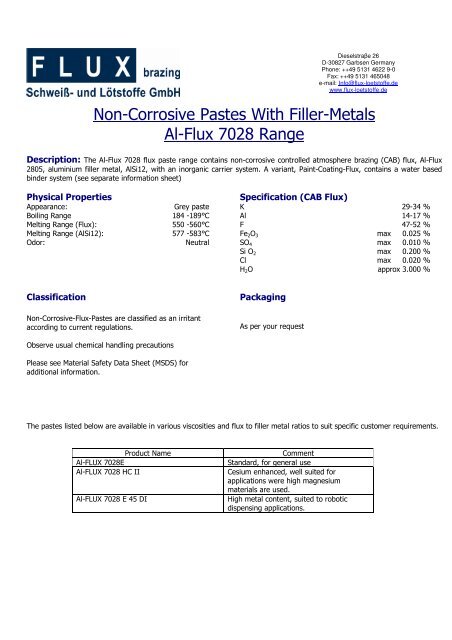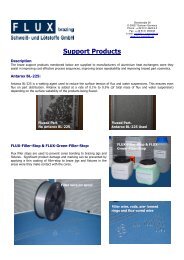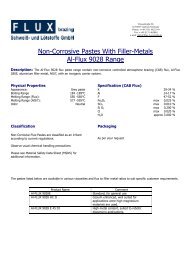Non-Corrosive Pastes With Filler-Metals Al-Flux 7028 Range
Non-Corrosive Pastes With Filler-Metals Al-Flux 7028 Range
Non-Corrosive Pastes With Filler-Metals Al-Flux 7028 Range
You also want an ePaper? Increase the reach of your titles
YUMPU automatically turns print PDFs into web optimized ePapers that Google loves.
Dieselstraβe 26<br />
D-30827 Garbsen Germany<br />
Phone: ++49 5131 4622 9-0<br />
Fax: ++49 5131 465048<br />
e-mail: Info@flux-loetstoffe.de<br />
www.flux-loetstoffe.de<br />
<strong>Non</strong>-<strong>Corrosive</strong> <strong>Pastes</strong> <strong>With</strong> <strong>Filler</strong>-<strong>Metals</strong><br />
<strong>Al</strong>-<strong>Flux</strong> <strong>7028</strong> <strong>Range</strong><br />
Description: The <strong>Al</strong>-<strong>Flux</strong> <strong>7028</strong> flux paste range contains non-corrosive controlled atmosphere brazing (CAB) flux, <strong>Al</strong>-<strong>Flux</strong><br />
2805, aluminium filler metal, <strong>Al</strong>Si12, with an inorganic carrier system. A variant, Paint-Coating-<strong>Flux</strong>, contains a water based<br />
binder system (see separate information sheet)<br />
Physical Properties Specification (CAB <strong>Flux</strong>)<br />
Appearance: Grey paste K 29-34 %<br />
Boiling <strong>Range</strong> 184 -189°C <strong>Al</strong> 14-17 %<br />
Melting <strong>Range</strong> (<strong>Flux</strong>): 550 -560°C F 47-52 %<br />
Melting <strong>Range</strong> (<strong>Al</strong>Si12): 577 -583°C Fe2O3 max 0.025 %<br />
Odor: Neutral SO4 max 0.010 %<br />
Si O2 max 0.200 %<br />
Cl max 0.020 %<br />
H2O approx 3.000 %<br />
Classification Packaging<br />
<strong>Non</strong>-<strong>Corrosive</strong>-<strong>Flux</strong>-<strong>Pastes</strong> are classified as an irritant<br />
according to current regulations.<br />
Observe usual chemical handling precautions<br />
Please see Material Safety Data Sheet (MSDS) for<br />
additional information.<br />
As per your request<br />
The pastes listed below are available in various viscosities and flux to filler metal ratios to suit specific customer requirements.<br />
Product Name Comment<br />
<strong>Al</strong>-FLUX <strong>7028</strong>E Standard, for general use<br />
<strong>Al</strong>-FLUX <strong>7028</strong> HC II Cesium enhanced, well suited for<br />
applications were high magnesium<br />
materials are used.<br />
<strong>Al</strong>-FLUX <strong>7028</strong> E 45 DI High metal content, suited to robotic<br />
dispensing applications.
<strong>Non</strong>-<strong>Corrosive</strong> <strong>Pastes</strong> <strong>With</strong> <strong>Filler</strong>-<strong>Metals</strong><br />
<strong>Al</strong>-<strong>Flux</strong> <strong>7028</strong> <strong>Range</strong><br />
<strong>Al</strong>-FLUX <strong>7028</strong> flux pastes contain <strong>Al</strong>-<strong>Flux</strong> 2805 as the active component. <strong>Al</strong>Si12<br />
metal is added as a filler metal.<br />
These pastes are widely used where additional filler metal is required and can<br />
replace most braze operations where filler metal rings and flux pastes are used.<br />
The advantage is that a single product is used. No mixing is required. No filler<br />
metal pre-forms need be manufactured and stocked. <strong>Flux</strong> and filler metal are<br />
applied in a single, controllable operation and the flux to filler metal ratio is<br />
controlled. This reduces unwanted post-braze crystals as a result of over fluxing.<br />
Uses include problematic braze joint areas on furnace brazed aluminium heat<br />
exchangers, for example, large gaps at tube to header joints caused by poor part<br />
stamping. Leaks can be repaired by applying <strong>Al</strong>-<strong>Flux</strong> <strong>7028</strong>E to the leak area and<br />
re-brazing the defective unit.<br />
Multi flow condenser connector block to header pipe brazing is improved by the use of <strong>Al</strong>-<br />
<strong>Flux</strong> <strong>7028</strong>E. <strong>Al</strong>-<strong>Flux</strong> <strong>7028</strong> HC II can be used if the connector material contains significant<br />
amounts of magnesium.<br />
<strong>Non</strong>-clad parts can be joined using these pastes.<br />
<strong>Al</strong>-<strong>Flux</strong> <strong>7028</strong>E paste is used extensively in the cookware industry to join aluminium bases<br />
to stainless steel pots.<br />
<strong>Al</strong>-<strong>Flux</strong> <strong>7028</strong>:<br />
– CAB flux (<strong>Al</strong>-<strong>Flux</strong> 2805)<br />
– <strong>Al</strong>Si12 <strong>Filler</strong> metal<br />
– Inorganic carrier system<br />
– Cesium complex can be added<br />
Process:<br />
Application:<br />
– Spray<br />
– Dispense<br />
– Dip<br />
– Brush<br />
Brazing:<br />
– Controlled Atmosphere Brazing (CAB)<br />
– Induction<br />
– Indirect flame<br />
Benefits of <strong>Al</strong>-<strong>Flux</strong> <strong>7028</strong>:<br />
- Cost competitive product<br />
- Improved process<br />
- Reduced inventory<br />
- Balanced flux to filler metal ratio<br />
- Excellent braze fillet formation<br />
Conclusion:<br />
Capillary tube brazed to pipe using<br />
<strong>Al</strong>-<strong>Flux</strong> <strong>7028</strong>E<br />
Excellent braze fillet formation<br />
Photo 3: Coated And Un-Coated Evaporator Plates<br />
<strong>Al</strong>-<strong>Flux</strong> <strong>7028</strong> flux pastes provide practical solutions for the application of filler metal in braze joints.<br />
Manifold to evaporator core brazing<br />
using <strong>Al</strong>-<strong>Flux</strong> <strong>7028</strong> E 45 Di<br />
Photo courtesy of Vulkan<br />
Manifold after<br />
indirect flame<br />
brazing<br />
FLUX GmbH is the leader in fluxing technologies and is continuously developing customer specific solutions to achieve<br />
maximum cost benefit in the processing sequence of heat exchange products. Issued 04/2011






